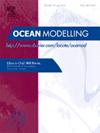Role of atmospheric and oceanographic frequency variability on surface Marine Heatwaves in the Northern Humboldt Current System
IF 2.9
3区 地球科学
Q2 METEOROLOGY & ATMOSPHERIC SCIENCES
引用次数: 0
Abstract
In this study, we investigated the role of atmospheric and oceanographic variability in shaping surface Marine Heatwaves (MHWs) in the Northern Humboldt Current System (NHCS) over the last two decades. Through a series of pluriannual hydrodynamic model simulations, we highlighted the importance of considering at least high-frequency atmospheric variability to accurately reproduce the observed MHW characteristics. On the contrary, when synoptic atmosphere variability is removed, the simulation results in fewer, longer, less frequent, less intense, and less severe MHWs. As a consequence, simulations forced with low-frequency data are only able to partially reproduce persistent MHWs. Additionally, using the heat balance analysis, it is shown that at the north, short-lived events are primarily driven by advective causes, while persistent events show an equal contribution between advection and heat fluxes. In the south, changes in heat fluxes are crucial in forming MHWs. During the dissipation phase of MHWs, cooling is dominated by advective processes, mainly coastal upwelling, in both coastal regions. Overall, these findings indicate a reduced dependence on high-frequency oceanic forcing and highlight the need to consider the atmospheric variability in regional downscaling of global climate model simulations to capture almost the full range of MHW events in the NHCS.
北洪堡流系统中大气和海洋频率变化对海洋表面热浪的影响
在这项研究中,我们研究了近20年来大气和海洋变率在北洪堡流系统(NHCS)表面海洋热浪(MHWs)形成中的作用。通过一系列的多年水动力模式模拟,我们强调了至少考虑高频大气变率对于准确再现观测到的MHW特征的重要性。相反,当天气大气变率被去除时,模拟结果中出现的强震更少、时间更长、频率更低、强度更低、严重程度更低。因此,使用低频数据的模拟只能部分重现持久的强震。此外,利用热平衡分析表明,在北方,短期事件主要由平流原因驱动,而持续事件在平流和热通量之间表现出同等的贡献。在南方,热通量的变化对强对流的形成至关重要。在强震消散阶段,两个沿海地区的冷却以平流过程为主,主要是沿岸上升流。总的来说,这些发现表明对高频海洋强迫的依赖性降低,并强调需要在全球气候模式模拟的区域降尺度中考虑大气变率,以便在国家气候中心中捕捉几乎全部的强震事件。
本文章由计算机程序翻译,如有差异,请以英文原文为准。
求助全文
约1分钟内获得全文
求助全文
来源期刊

Ocean Modelling
地学-海洋学
CiteScore
5.50
自引率
9.40%
发文量
86
审稿时长
19.6 weeks
期刊介绍:
The main objective of Ocean Modelling is to provide rapid communication between those interested in ocean modelling, whether through direct observation, or through analytical, numerical or laboratory models, and including interactions between physical and biogeochemical or biological phenomena. Because of the intimate links between ocean and atmosphere, involvement of scientists interested in influences of either medium on the other is welcome. The journal has a wide scope and includes ocean-atmosphere interaction in various forms as well as pure ocean results. In addition to primary peer-reviewed papers, the journal provides review papers, preliminary communications, and discussions.
 求助内容:
求助内容: 应助结果提醒方式:
应助结果提醒方式:


